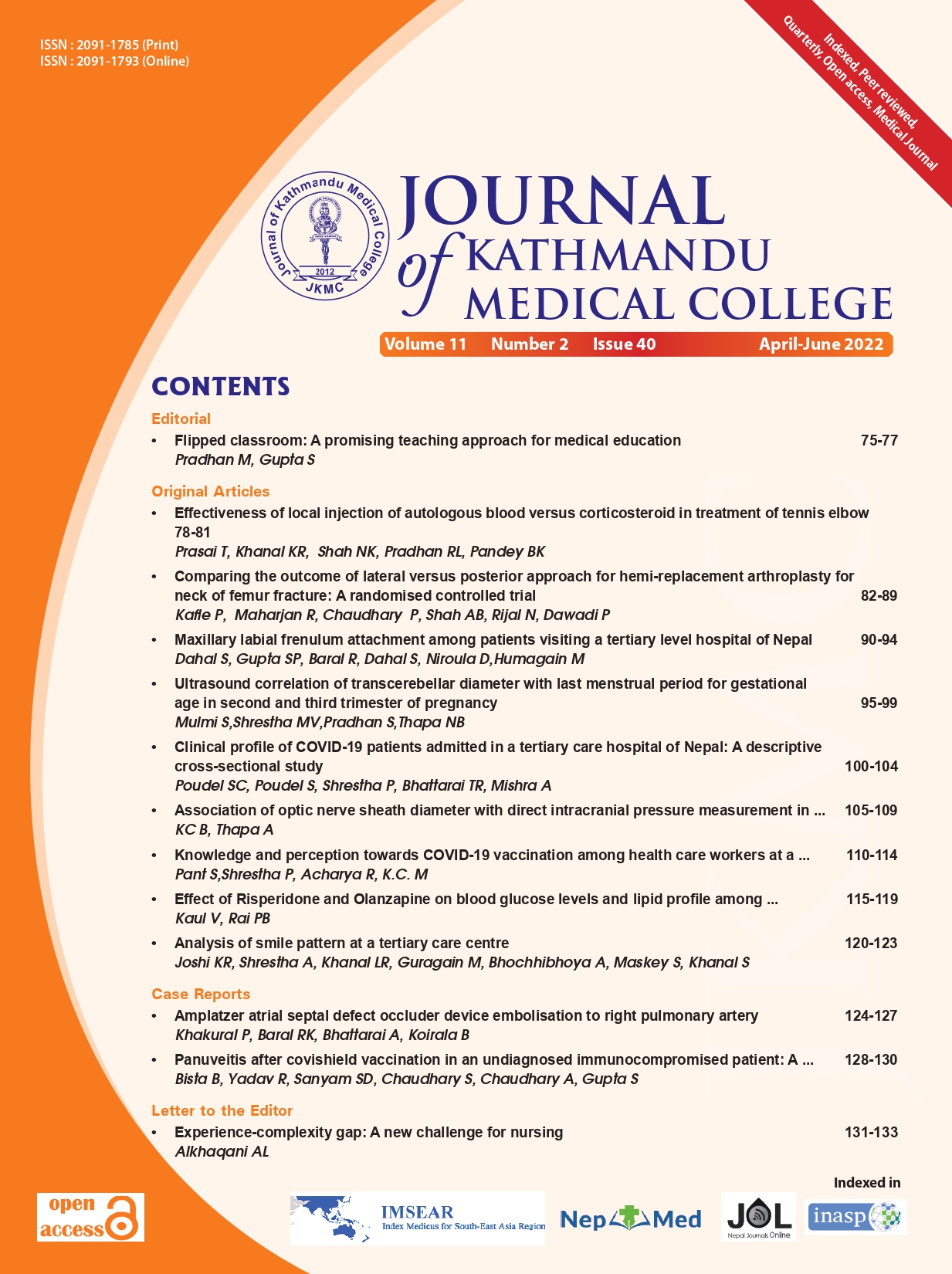Effectiveness of local injection of autologous blood versus corticosteroid in treatment of tennis elbow
DOI:
https://doi.org/10.3126/jkmc.v11i2.48666Keywords:
autologous blood, Corticosteroid , Tennis ElbowAbstract
Background: Tennis elbow or lateral epicondylitis is characterised by pain and tenderness at the lateral epicondyle of humerus. There are various treatment modalities recommended, but there is no universally accepted therapeutic modality yet.
Objectives: To compare the functional outcomes of local injection of corticosteroid versus autologous whole blood for tennis elbow.
Methods: This was a non-randomised trial conducted from May 2020 to January 2021 after ethical clearance. Patients attending orthopaedic surgery outpatient department, Kathmandu Medical College with lateral epicondylitis of the humerus were included by convenience sampling into corticosteroid group or autologous blood injection group based on whether they presented on odd or even calendar days respectively. There were 38 patients in corticosteroid group and 36 patients in autologous blood group. The visual analogue scale (VAS) and Nirschl staging system were calculated before injection, and then at one week, six weeks, and six months after injection.
Results: Patients in both groups showed statistically significant decrease in pain from preinjection scores on both VAS and Nirschl scale at all follow-ups. There was no statistically significant difference between the two groups up to six weeks. At six months, autologous blood injection group showed statistically significant decrease in pain compared with corticosteroid injection group on both scoring systems.
Conclusion: Both groups showed comparable improvement up to six-week follow-up. Autologous blood injection group had significantly better improvement at six months. Autologous blood injection was more effective than corticosteroid injection at midterm follow-up, and had lower recurrence rate.
Downloads
References
Dojode CM. A randomised control trial to evaluate the efficacy of autologous blood injection versus local corticosteroid injection for treatment of lateral epicondylitis. Bone Joint Res. 2012 Aug 1;1(8):192-7.[Pubmed | Full text | DOI]
Kannus P., Józsa L. Histopathological changes preceding spontaneous rupture of a tendon: a controlled study of 891 patients. The Journal of Bone & Joint Surgery. 1991;73(10):1507–1525. doi: 10.2106/00004623-199173100-00009.[Pubmed | Full Text ]
Regan W, Wold LE, Coonrad R, Morrey BF. Microscopic histopathology of chronic refractory lateral epicondylitis. Am J Sports Med. 1992 Nov-Dec;20(6):746-9. doi: 10.1177/036354659202000618. PMID: 1280910.[PubMed | Full Text | DOI ]
Sims SE, Miller K, Elfar JC, Hammert WC. Non-surgical treatment of lateral epicondylitis: a systematic review of randomized controlled trials. Hand (N Y). 2014 Dec;9(4):419-46. doi: 10.1007/s11552-014-9642-x. PMID: 25414603; PMCID: PMC4235906. [PubMed | Full Text | DOI]
Hay E. M., Paterson S. M., Lewis M., et al. Pragmatic randomised controlled trial of local corticosteroid injection and naproxen for treatment of lateral epicondylitis of elbow in primary care. BMJ. 1999;319(7215):964–968. doi: 10.1136/bmj.319.7215.964 [PubMed | Full Text | DOI]
Edwards SG, Calandruccio JH. Autologous blood injections for refractory lateral epicondylitis. J Hand Surg Am 2003;28-A:272–8.[ PubMed | Full Text | DOI ]
Wolf JM, Ozer K, Scott F, Gordon MJ, Williams AE. Comparison of autologous blood, corticosteroid, and saline injection in the treatment of lateral epicondylitis: a prospective, randomized, controlled multicenter study. J Hand Surg Am 2011; 36:1269–72.[ PubMed | Full Text | DOI ]
Hamilton PG. The prevalence of humeral epicondylitis: a survey in general practice. The Journal of the Royal College of General Practitioners. 1986 Oct 1;36(291):464-5.[ PubMed | Full Text ]
Verhaar JA. Tennis elbow [thesis]. Maastricht: State University Maastricht. 1992.
Gruchow HW, Pelletier D. An epidemiologic study of tennis elbow: incidence, recurrence, and effectiveness of prevention strategies. The American Journal of Sports Medicine. 1979 Jul;7(4):234-8.[ PubMed | Full Text | DOI]
Nirschl RP. Tennis elbow. Primary Care: Clinics in Office Practice. 1977 Jun 1;4(2):367-82.
Bisset L, Beller E, Jull G, Brooks P, Darnell R, Vicenzino B. Mobilisation with movement and exercise, corticosteroid injection, or wait and see for tennis elbow: randomised trial. Bmj. 2006 Nov 2;333(7575):939.[ PubMed | Full Text | DOI]
Downloads
Published
How to Cite
Issue
Section
License
Copyright © Journal of Kathmandu Medical College
The ideas and opinions expressed by authors or articles summarized, quoted, or published in full text in this journal represent only the opinions of the authors and do not necessarily reflect the official policy of Journal of Kathmandu Medical College or the institute with which the author(s) is/are affiliated, unless so specified.
Authors convey all copyright ownership, including any and all rights incidental thereto, exclusively to JKMC, in the event that such work is published by JKMC. JKMC shall own the work, including 1) copyright; 2) the right to grant permission to republish the article in whole or in part, with or without fee; 3) the right to produce preprints or reprints and translate into languages other than English for sale or free distribution; and 4) the right to republish the work in a collection of articles in any other mechanical or electronic format.




